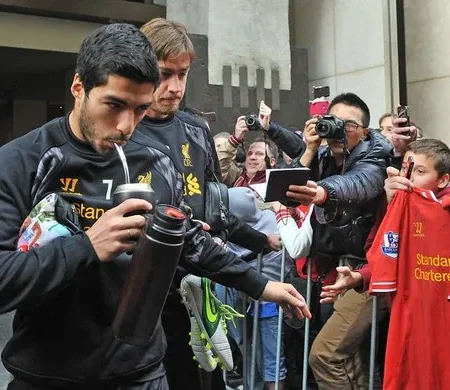In the heart of South America, a time-honored tradition is making waves far beyond its origins. Mate, pronounced mah-teh, is a caffeinated drink that has transcended its regional roots to become a global sensation, thanks in large part to the world of football. This humble beverage, made by steeping yerba mate leaves in warm water, has not only fueled countless athletes but also brought a slice of South American culture to international prominence.
A Cultural Staple with Ancient Origins

Yerba mate, derived from a type of holly native to South America, was first consumed by the Guarani, an indigenous group inhabiting present-day Paraguay, Argentina, Uruguay, and southern Brazil. For the Guarani and their descendants, mate is more than just a drink; it is a symbol of heritage and community. Raul Romero of Argentina’s National Yerba Mate Institute emphasizes this deep connection, noting that “the drink has deep cultural, social, and economic roots.”
Traditionally, mate is prepared in a calabash, a dried, hollowed-out gourd, and sipped through a bombilla, a silver straw that filters the leaves. The ritual of preparing and sharing mate has been a cornerstone of South American social life for centuries, fostering connections and conversations across generations.
Football: The Catalyst for Mate’s Global Journey

In recent years, mate has found an unlikely ambassador in the world of football. The sight of players like Lionel Messi, Luis Suarez, and Emi Martinez clutching their mate gourds and thermos flasks has become commonplace, from team buses to locker rooms. These athletes have not only adopted mate as a personal ritual but have also played a crucial role in its global dissemination.
As South American teams traveled for international tournaments like the Copa America and the FIFA World Cup, they brought their beloved drink along. During the 2022 World Cup in Qatar, the Argentine team famously transported 240 kilograms of yerba mate, underscoring its importance. “The players are all fanatical about it,” says Uruguay’s press officer Felipe Cotelo. “They’re drinking it constantly. It won’t run out. But if it does, we’ll just send for more.”
Health Benefits: Fueling Performance and Well-being

The appeal of mate extends beyond its cultural significance. It is packed with antioxidants, vitamins, and minerals, and contains caffeine levels higher than black tea but lower than coffee. Jose Blesa, head of sports nutrition at FC Basel, highlights mate’s benefits for athletes, noting that “players who drink mate tend to be better hydrated because they drink more fluids.” The caffeine in mate boosts stamina, energy, and mental focus, while its antioxidants help strengthen the immune system.
However, Blesa advises moderation, particularly in the evenings, to avoid insomnia. Despite this, the adaptability of mate rituals — whether in the morning, before matches, or during social gatherings — adds to its allure, making it a staple in many athletes’ routines.
Mate: A Social Glue and Cultural Phenomenon
Mate’s resurgence is not limited to the pitch. In Argentina, annual consumption exceeds six kilograms per capita, and the drink is present in over 90 percent of households. The nation celebrates a National Day of Mate, boasts mate sommeliers, and offers a variety of mate-flavored products, including ice cream and crisps adorned with the face of Lionel Messi.
Uruguay shares this passion. The country recently featured giant, multi-colored mate cups in an art installation in Montevideo’s Independence Square, and their national team mascot at the 2022 World Cup was a human-sized thermos named Botija. The creation of a mate emoji in 2019 even sparked nationwide celebrations.
This enthusiasm sometimes leads to controversies, as seen when Argentina brought Uruguayan-grown yerba mate to the World Cup, prompting outcry from local politicians. In response, the Argentine football federation ensured that the team drank only locally sourced mate at subsequent tournaments, highlighting the beverage’s patriotic significance.
Spreading Beyond Borders

Mate’s influence has spread far beyond South America, finding a foothold in Europe and beyond. France’s Antoine Griezmann and England’s Eric Dier are among the many footballers who have embraced the drink, thanks to their South American teammates. “We have a lot of Argentinians, so I started drinking it with them,” Dier said. “Now the English players are trying to pretend to be South Americans. I am a bit addicted to it.”
This global adoption underscores mate’s unique ability to foster human connection. In a world where digital interactions often replace face-to-face conversations, the ritual of sharing mate offers a rare opportunity for genuine social bonding. “When you have a mate with someone, it’s like an invitation to share,” says former Uruguay player Diego Viera. “It unites people.”
A Drink for the Ages
As Argentina and Uruguay gear up for their Copa America semi-finals, mate’s presence is more pronounced than ever. The drink that once seemed exotic is now a symbol of shared culture and camaraderie, bridging continents and communities. Whether you’re a football fan or simply curious about new cultural experiences, trying mate might just offer you a taste of that unique blend of tradition and togetherness. In a world that often feels fragmented, mate exemplifies how simple rituals can unite people, one sip at a time.


